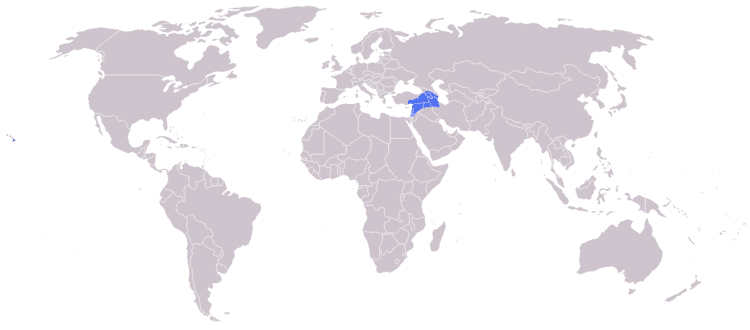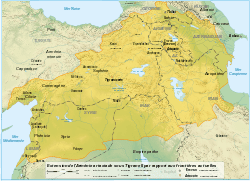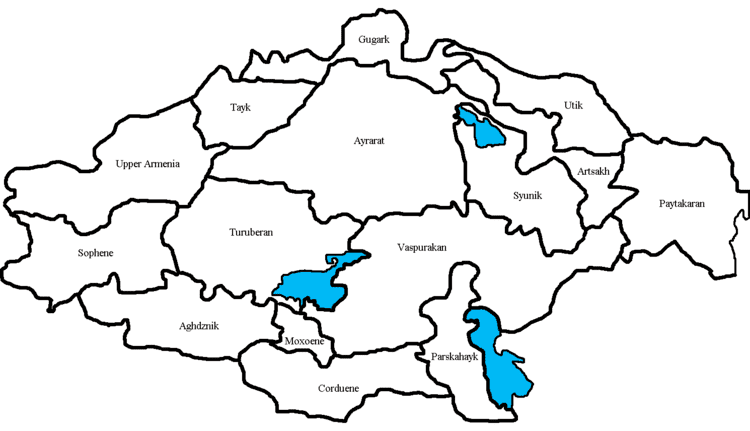Satrapy of Armenia is formed c. 533 BC Founded 331 BC Government Absolute monarchy | Christianity national religion 301 AD Area 120,000 km² Date dissolved 428 AD | |
Religion Armenian polytheism and Zoroastrianism 3rd century BC – 301 ADChristianity (Armenian Church) from 301 AD Capitals | ||
Kingdom of armenia antiquity
The Kingdom of Armenia, also the Kingdom of Greater Armenia, or simply Greater Armenia (Armenian: Մեծ Հայք Mets Hayk; Latin: Armenia Maior), was a monarchy in the Ancient Near East which existed from 321 BC to 428 AD. Its history is divided into successive reigns by three royal dynasties: Orontid (321 BC–200 BC), Artaxiad (189 BC–12 AD) and Arsacid (52–428). It is widely believed to be the region with which all Armenians descend from.
Contents
- Kingdom of armenia antiquity
- Origins
- Orontid Dynasty
- Artaxiad dynasty
- Roman rule
- Arsacid dynasty
- Army
- Under Tigranes the Great
- Ayrudzi
- Legio I Armeniaca Armenian First Legion
- Legio II Armeniaca Armenian Second Legion
- Mythology and pre Christian religion
- Zoroastrianism
- Literature
- Language
- Capitals
- Political geography
- Provinces
- References

The root of the kingdom lies in one of the satrapies of the Achaemenid Empire of Persia called Armenia (Satrapy of Armenia), which was formed from the territory of the Kingdom of Ararat (860 BC–590 BC) after it was conquered by the Median Empire in 590 BC. The satrapy became a kingdom in 321 BC during the reign of the Orontid dynasty after the conquest of Persia by Alexander the Great, which was then incorporated as one of the Hellenistic kingdoms of the Seleucid Empire.

Under the Seleucid Empire (312-63 BC), the Armenian throne was divided in two – Armenia Maior and Sophene – both of which passed to members of the Artaxiad dynasty in 189 BC. During the Roman Republic's eastern expansion, the Kingdom of Armenia, under Tigranes the Great, reached its peak, from 83 to 69 BC, after it reincorporated Sophene and conquered the remaining territories of the falling Seleucid Empire, effectively ending its existence and raising Armenia into an empire for a brief period, until it was itself conquered by Rome in 69 BC. The remaining Artaxiad kings ruled as clients of Rome until they were overthrown in 12 AD due to their possible allegiance to Rome's main rival in the region, Parthia.

During the Roman–Parthian Wars, the Arsacid dynasty of Armenia was founded when Tiridates I, a member of the Parthian Arsacid dynasty, was proclaimed King of Armenia in 52. Throughout most of its history during this period, Armenia was heavily contested between Rome and Parthia, and the Armenian nobility was divided among pro-Roman, pro-Parthian or neutrals. From 114 to 118, Armenia briefly became a province of the Roman Empire under Emperor Trajan. The Kingdom of Armenia often served as a client state or vassal at the frontier of the two large empires and their successors, the Byzantine and Sassanid empires. In 301, Tiridates III proclaimed Christianity as the state religion of Armenia, making the Armenian kingdom the first state to embrace Christianity officially.

During the Byzantine–Sasanian wars, Armenia was ultimately partitioned into Byzantine Armenia in 387 and Persian Armenia in 428.
Kingdom of armenia antiquity
Origins

The geographic Armenian Highlands, then known as the highlands of Ararat (Assyrian: Urartu), was originally inhabited by Proto-Armenian tribes which did not yet constitute a unitary state or nation. The highlands were first united by tribes in the vicinity of Lake Van into the Kingdom of Van (Urartian: Biainili). The kingdom competed with Assyria over supremacy in the highlands of Ararat and the Fertile Crescent.

Both kingdoms fell to Iranian invaders from the neighbouring East (Medes, followed by Achaemenid Persians) in the 6th century BC. Its territory was reorganized into a satrapy called Armenia (Old Persian: Armina, Elamite: Harminuya, Akkadian: Urashtu). The Orontid dynasty ruled as satraps of the Achaemenid Empire for three centuries until the empire's defeat against Alexander the Great's Macedonian Empire at the Battle of Gaugamela in 331 BC. After Alexander's death in 323 BC, a Macedonian general named Neoptolemus obtained Armenia until he died in 321 BC and the Orontids returned, not as satraps, but as kings.
Orontid Dynasty
Orontes III and the ruler of Lesser Armenia, Mithridates, recognized themselves independent, thus elevating the former Armenian satrapy into a kingdom, giving birth to the kingdoms of Armenia and Lesser Armenia. Orontes III also defeated the Thessalian commander Menon, who wanted to capture Sper's gold mines.
Weakened by the Seleucid Empire which succeeded the Macedonian Empire, the last Orontid king, Orontes IV, was overthrown in 200/201 BC and the kingdom was taken over by an commander of the Seleucid Empire, Artashes I, who is presumed to be related to the Orontid dynasty himself.
Artaxiad dynasty
The Seleucid Empire's influence over Armenia had weakened after it was defeated by the Romans in the Battle of Magnesia in 190 BC. A Hellenistic Armenian state was thus founded in the same year by Artaxias I alongside the Armenian kingdom of Sophene led by Zariadres. Artaxias seized Yervandashat, united the Armenian Highlands at the expense of neighboring tribes and founded the new royal capital of Artaxata near the Araxes River. According to Strabo and Plutarch, Hannibal Barca received hospitality at the Armenian court of Artaxias I. The authors add an apocryphal story of how Hannibal planned and supervised the building of Artaxata. The new city was laid on a strategic position at the juncture of trade routes that connected the Ancient Greek world with Bactria, India and the Black Sea which permitted the Armenians to prosper. Tigranes the Great saw opportunity for expansion in the constant civil strife to the south. In 83 BC, at the invitation of one of the factions in the interminable civil wars, he entered Syria, and soon established himself as ruler of Syria, putting the Seleucid Empire virtually at an end and ruled peacefully for 17 years. During the zenith of his rule, Tigranes the Great, extended Armenia's territory outside of the Armenian Highland over parts of the Caucasus and the area that is now south-eastern Turkey, Iran, Syria and Lebanon, becoming one of the most powerful states in the Roman East.
Roman rule
Armenia came under the Ancient Roman sphere of influence in 66 BC, after the battle of Tigranocerta and the final defeat of Armenia's ally, Mithridates VI of Pontus. Mark Antony invaded and defeated the kingdom in 34 BC, but the Romans lost hegemony during the Final War of the Roman Republic in 32–30 BC. In 20 BC, Augustus negotiated a truce with the Parthians, making Armenia a buffer zone between the two major powers.
Augustus installed Tigranes V as king of Armenia in AD 6, but ruled with Erato of Armenia. The Romans then installed Mithridates of Armenia as client king. Mithridates was arrested by Caligula, but later restored by Claudius. Subsequently, Armenia was often a focus of contention between Rome and Parthia, with both major powers supporting opposing sovereigns and usurpers. The Parthians forced Armenia into submission in AD 37, but in AD 47 the Romans retook control of the kingdom. In AD 51 Armenia fell to an Iberian invasion sponsored by Parthia, led by Rhadamistus. Tigranes VI of Armenia ruled from AD 58, again installed by Roman support. The period of turmoil ends in AD 66, when Tiridates I of Armenia was crowned king of Armenia by Nero. For the remaining duration of the Armenian kingdom, Rome still considered it a client kingdom de jure, but the ruling dynasty was of Parthian extraction, and contemporary Roman writers thought that Nero had de facto yielded Armenia to the Parthians.
Arsacid dynasty
Under Nero, the Romans fought a campaign (55–63) against the Parthian Empire, which had invaded the Kingdom of Armenia, allied with the Romans. After gaining Armenia in 60, then losing it in 62, the Romans sent the Legio XV Apollinaris from Pannonia to Gnaeus Domitius Corbulo, legatus of Syria. In 63, strengthened further by the legions III Gallica, V Macedonica, X Fretensis and XXII, General Corbulo entered into the territories of Vologases I of Parthia, who then returned the Armenian kingdom to Tiridates, king Vologases I's brother.
Another campaign was led by Emperor Lucius Verus in 162–165, after Vologases IV of Parthia had invaded Armenia and installed his chief general on its throne. To counter the Parthian threat, Verus set out for the east. His army won significant victories and retook the capital. Sohaemus, a Roman citizen of Armenian heritage, was installed as the new client king. But during an epidemic within the Roman forces, Parthians retook most of their lost territory in 166. Sohaemus retreated to Syria, аnd Arsacid's dynasty was restored power over Armenia.
After the fall of the Arsacid dynasty in Persia, the succeeding Sasanian Empire aspired to reestablish Persian control. The Sassanid Persians occupied Armenia in 252. However, in 287, Tiridates III the Great was established King of Armenia by the Roman armies. After Gregory the Illuminator's spreading of Christianity in Armenia, Tiridates accepted Christianity and made it his kingdom's official religion. The traditional date for Armenia's conversion to Christianity is established at 301, which precedes the Roman Emperor Constantine the Great's conversion and the Edict of Milan by a dozen years.
In 387, the Kingdom of Armenia was split between the Eastern Roman Empire and the Persians. Western Armenia quickly became a province of the Roman Empire under the name of Armenia Minor, and becoming later Byzantine Armenia; Eastern Armenia remained a kingdom within Persia until 428, when the local nobility overthrew the king, and the Sassanids installed a governor in his place, beginning the so-called Marzpanate period over Persian Armenia. Those parts of historical Armenia remained thus in firm Persian hands until the Muslim conquest of Persia, while the Byzantine parts were also conquered by the invading Arabs in the course of the 7th century. In 885, after years of Roman, Persian, and Arab rule, Armenia regained its independence under the Bagratuni dynasty.
Army
The Kingdom of Armenia had an army of 100,000 to 120,000.
Under Tigranes the Great
The army of Kingdom of Armenia was at peak under the reign of Tigranes the Great. According to the author of Judith, his army included chariots and 12,000 cavalrymen, probably indicating heavy cavalry or cataphracts, commonly used by Seleucids and Parthians. He also had 120,000 infantrymen and 12,000 mounted archers, which were also an important feature of the Parthian army. Like the Seleucids, the bulk of Tigranes' army were foot soldiers. The Jewish historian Josephus talks of 500,000 men in total, including the camp followers. These latter were the camels, donkeys, and mules for the baggage; innumerable sheep, cattle, and goats for the food supply which was abundant for each man, and much gold and silver. As a result, the marching Armenian army was "a huge, irregular force, too many to count, like locusts or the dust of the earth". It was thus not unlike the other enormous Eastern armies of the time. Regardless, the smaller Cappadocian, Graeco-Phoenician, and Nabataean armies were no match for the sheer number of soldiers. However, the organized Roman army with its legions posed a much greater challenge to the Armenians.
Note that the numbers given by Israelite historians of the time were probably exaggerated, considering the fact that the Hasmonean Jews lost the war against Tigranes.
Ayrudzi
From ancient times in Armenia there existed "Azatavrear" cavalry which consisted of the Armenian elite. "Azatavrear" cavalry was the main part of the Armenian king's court. Later, in medieval times "Azatavrear" cavalry or Armenian heavy cavalry was collected from nobles (youngest sons of Armenian lords) and was known as AYRUDZI (man and horse, horseman). During times of peace, Armenian cavalry was divided into a number of small groups which took the role of guarding the King and his family as well as Armenian lords. Some part of the Armenian cavalry was always patrolling the Armenian borders under the command of an Armenian general (sparapet). The Group of Armenian cavalry whose main mission was the protection of the Armenian king and his family consisted of 6000 heavily armored horsemen in the ancient period, and 3000 horsemen in the medieval period. During times of war, the number of Armenian cavalry could be anywhere from 10,000 to 20,000 horsemen or more. Beside heavy cavalry there was also light cavalry, which mainly consisted of mounted archers.
Legio I Armeniaca-Armenian First Legion
"Legio Armeniaca" translated from Latin as "Armenian Legion" and "prima" as "first". The Armenian First Legion was one of the later period Roman empire legions. This Legion is mentioned in the late-antique text known as Notitia Dignitatum. It is most likely that Armenian First Legion was formed in the 2nd or 3rd centuries AD, in the Western part of Kingdom of Armenia and that its mission was to protect the Armenian lands from intrusion. It should first have been the garrison of Armenian lands which had been under the control of Roman Empire. Armenian First Legion took part in the ill-fated Persian campaign of the emperor Julianus Apostata in 363.
Legio II Armeniaca-Armenian Second Legion
"Legio Armeniaca" translated from Latin as "Armenian Legion" and "Secunda" as "Second". Armenian Second Legion like Armenian First legion was one of the later-period Roman Empire legions. This legion is also mentioned in the Notitia Dignitatum. Armenian Second Legion was probably created at the end of the 3rd century or in the beginning of the 4th century. Armenian Second Legion had a permanent camp in one of the Northern provinces of the Orient. This legion built a camp in Satala. Armenian Second legion is furthermore mentioned in the year 360AD as a part of the garrison of Bezabda (anciently called Phoencia) at the upper Tigris. In Bezabde Armenian Second Legion served together with Legions Parthica and II Flavia. In 390AD Bezabde was taken by the Persians and a terrible bloodbath ensued against the inhabitants and garrison. Nevertheless, the legion seems to have survived this battle, because it appears in Notitia Dignitatum which was written in the 5th century.
Later on Armenian Second legion became a part of the Byzantine army.
Mythology and pre-Christian religion
The pre-Christian Armenian pantheon included:
During the 1st century AD, Christianity spread through Armenia due to (according to legend) the efforts of the apostles Bartholomew and Thaddeus. After persecutions by kings Sanatruk, Axidares, Khosrov I, and Tiridates III, Christianity was adopted as the state religion by Tiridates III after he was converted by Gregory the Illuminator. Armenia's adoption of Christianity as the state religion (the first country to do so), distinguished it from Parthian and Mazdaen influence.
Zoroastrianism
Until the late Parthian period, Armenia was a predominantly Zoroastian-adhering land. With the advent of Christianity, both paganism and Zoroastrianism gradually started to diminish. The founder of the Arsacid branch in Armenia, Tiridates I was a Zoroastrian priest or magus. A noted episode which illustrates the observance by the Armenian Arsacids is the famous journey of Tiridates I to Rome in A.D. 65-66. With the acceptance of Christianity in the earliest 4th century, its presence in the kingdom gradually started to decline.
Literature
Little is known about pre-Christian Armenian literature. Many literature pieces known to us were saved and then presented to us by Moses of Chorene. This is a pagan Armenian song, telling about the birth of Vahagn.
Language
Before the Armenian alphabet was created, Armenians used Aramaic and Greek alphabets, the last of which had a great influence on Armenian alphabet. The Armenian alphabet was created by Saint Mesrop Mashtots and Isaac of Armenia (Sahak Partev) in AD 405 primarily for a Bible translation into the Armenian language. Traditionally, the following phrase translated from Solomon's Book of Proverbs is said to be the first sentence to be written down in Armenian by Mashtots:
By the 2nd century BC, according to Strabo, the inhabitants of Greater Armenia spoke the Armenian language, implying that modern Armenians are descended from that population.
Capitals
Political geography
Kingdom of Armenia was bordered by Caucasian Albania in the east, by Caucasian Iberia in the north, by the Roman Empire in the west and by Parthia, later succeeded by Sasanian Empire. The border between Caucasian Iberia and Kingdom of Armenia was Kur river, which was also the border between Caucasian Albania and Kingdom of Armenia.
After 331 BC Armenia was divided into Lesser Armenia (a region of the Kingdom of Pontus), the Kingdom of Armenia (corresponding to Armenia Major) and the Kingdom of Sophene. In 189 BC when Artashes I's reign began, many neighboring countries (Media, Caucasian Iberia, Seleucid Empire) using the weakening of the kingdom, conquered the remote parts of the kingdom. Strabo says, that Artashes I raided to the east and reunited Caspiane and Paytakaran, then raided to the north, where Smbat Bagratuni defeated Georgian army, reuniting Gugark (Strabo also notes, that Georgians recognized themselves as vassals of the Kingdom of Armenia), to the west, reuniting Karin, Ekeghik and Derjan and to the south, where after many battles with Seleucid Empire he reunited Tmorik. But Artashes I wasn't able to reunite Lesser Armenia and Corduene, Sophene, and the work started by him, ended his grandson Tigranes the Great. During Artashes I's reign the Kingdom of Armenia covered 350,000 km2 (135,000 sq mi). At its peak, under Tigranes the Great, it covered 3,000,000 km2 (1,158,000 sq mi), incorporating, besides Armenia Major, Iberia, Albania, Cappadocia, Cilicia, Armenian Mesopotamia, Osroene, Adiabene, Syria, Assyria, Judea and Atropatene. Parthia and also some Arab tribes were vassals of Tigranes the Great. Lesser Armenia's area was 100,000 km2 (39,000 sq mi).
Provinces
The 15 provinces of the Kingdom of Armenia with their capitals are as follows:
Other Armenian regions:
